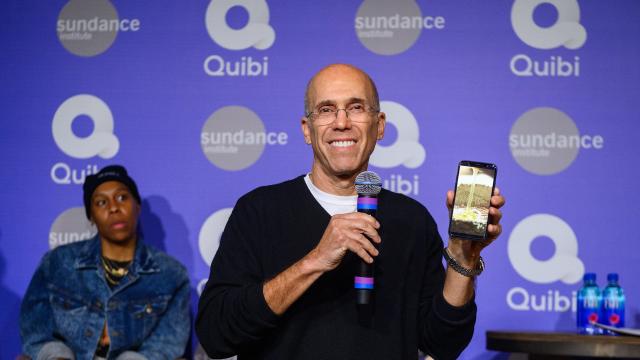I must confess, my first thought about Quibi was, “Quibi is a really stupid fucking name.” How do you even pronounce it? Is it like, kwih-bee, kwee-bye, kwi-bee? What does Quibi even mean? I still don’t know the answer to most of these questions, but thanks to a Wall Street Journal report, I now know that the name could’ve been much worse.
Admittedly, the WSJ story doesn’t focus much on the name itself. It’s mostly a dive into the weird power dynamics between Quibi CEO Meg Whitman and founder Jeffrey Katzenberg. However, as an example of the tension between the two, it drops an anecdote about what Quibi could have been named.
The executives wanted a name that captured the company’s strategy. Mr. Katzenberg was initially partial to “Omakase,” a term used to describe high-quality sushi selected by the chef. Ms. Whitman wasn’t in favour. The two agreed to set it aside.
The company hired a brand-strategy firm, Siegel+Gale, which helped come up with the name Quibi — short for “quick bites.”
Omakase. Wow.
The WSJ doesn’t really dig deep into why omakase is a ridiculous name for whatever it is Quibi is trying to be. Yes, it is most commonly used in reference to sushi, but words have context and nuance, dammit!
Directly translated, omakase is a Japanese phrase that means “I leave it to you.” It comes from the verb makaseru or “to entrust.” But I cannot stress enough the trust part of it.
One of my first freelance assignments as a baby-faced journalist in Tokyo was for a local food magazine about sushi etiquette. Basic stuff like how much soy sauce you’re supposed to use, what fish you’re supposed to use wasabi with (fatty ones) and which ones you aren’t (non-fatty ones), and how when you mix soy sauce and wasabi together you are deeply insulting your sushi chef. Part of the assignment was interviewing a Japanese sushi chef as I ate a whole five-course omakase meal.
The WSJ describes it as “high-quality sushi selected by a chef” but it’s a bit more than that. As this wizened sushi chef prepped my meal, he went deep into what omakase truly means. In his words, it was a customer telling him that they trusted that he knows best. That they were surrendering their ability to choose what they ate in exchange for a meal that is equal parts culinary tour de force and performance art. That trust was an honour, because as the diner, you are taking a huge gamble.
At that point, I didn’t have much yen in the bank and was used to kaiten sushi joints — the cheap conveyor belt places nestled in busy shopping malls next to Tokyo train stations. I almost exclusively ate crappy salmon nigiri and akami tuna; chuutoro or fatty tuna was a treat for payday or when I needed cheering up.
I was not prepared for a bonafide omakase experience. It started with a brief discussion of what type of sushi I enjoyed, what my budget was, and how open I was to trying something new. Once he understood what he had to work with, he then delivered a 2.5-hour meal that, seven years later, has never been surpassed in artistry or excellence. It was my first experience having a sushi chef bring out a blowtorch to sear some aburi toro. He lovingly, painstakingly, grated fresh wasabi so I could taste the difference from the cheap stuff you get from a tube. How I should dip my nigiri fish-side down to avoid mucking up the delicate sushi rice. He somehow convinced me to try shirako, which is cod sperm sac, and you know what, it was freaking delicious. To top things off, the man killed a sea urchin right in front of me and then expertly plated it. My Japanese friends had always told me I only hated uni because I’d never had good uni. Turns out, they were right.
I explain all this because omakase is the 180-degree opposite of the “quick bites” Quibi stands for. Quibi is a half-baked facsimile of a video streaming service that in its short life, has almost become synonymous with failure. Quibi had reportedly mustered 300,000 downloads at launch — a paltry showing at best.
Quibi’s pitch is short-form videos with high production value. Snackable content for when you have to kill a short amount of time. Except quick, flashy videos don’t exactly impart a sense of thoughtful curation. For all the star power, I haven’t heard a single person talk about how a Quibi show left a meaningful impression on their life. Sure, people debate the impressive technology behind Quibi, but I don’t think the words “artistry” and “Quibi” have been uttered in the same sentence until now. Seven years from now, I don’t think I will be waxing poetic about a 10-minute Quibi show watched out of morbid curiosity.
Cultural appropriation aside, it’s laughable that anyone ever thought omakase might have been a fitting name for a service that seems so haphazardly cobbled together. Nah, Quibi is exactly the name it deserves.
